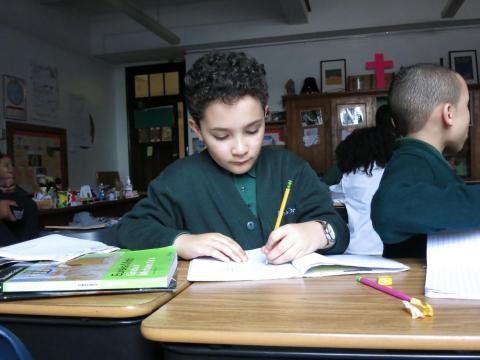Poetry Matters // How to Help Your Students Become Poets (Part 2 of 2)

In my last post on poetry, “Poetry Matters // The Case for Teaching Poetry in Every ELA Classroom,” I argued that poetry is an essential part of an English Language Arts education. I said that “poetry illuminates experience”—it can be the light within a microscope that helps us pause and appreciate the small details of our world (i.e. Mary Oliver), or it can be the glitter sprinkled on an idea we collectively think about all the time, a brilliant way of reimagining something we think we know everything about (just consider of the myriad ways that poets have written about love throughout history).
If that post made a case for “why” we should teach poetry in our classes, this post is the “how.” Here, I have tried to provide you with three concrete ways to help students realize that they too have the power to become poets. I share my thoughts below:

1. Expose Students to a Variety of Mentor Texts // For as much as poetry illuminates everyday, ordinary experience, it is not students’ primary discourse. It is essential, then, that students come to understand poetry’s “economy of words” by exposing them to a variety of mentor texts. To quote from a poet and teacher educator, Janine Certo, “Most of the time, we think of craft in poetry as arising from poetic features (e.g., rhyme, alliteration, repetition, metaphor). When such features are not taught in isolation, but rather through mentor texts, students display stanza sense in their poems, form their poetry into lines rather than sentences, and draw on repetition, rhyme, alliteration, and metaphor to enhance the meaning and mood of their poems.”
I often recommend that teachers and students subscribe to The Writer’s Almanac, as the Writer’s Almanac will deliver a “poem a day” to your inbox. Poetry 180, hosted by former poet laureate Billy Collins, is also an excellent source of both traditional and contemporary poems. In addition to reading poems, consider also listening to poetry with students. Nothing models the affective dimensions of language more powerfully than the work of Spoken Word poets.

2. Move Beyond Popularized Poetic Forms // Students’ perceptions of what constitutes poetry can sometimes limit them in their writing of poetry. Getting caught up in a quest to rhyme or abide by the syllable structure of a haiku might actually encourage students to produce what I call “cheap language” or trite clichés. Give students the time and space, then, to engage in open composition. Rather than instructing students to write a sonnet or a haiku, give them a task that will help them to “find” a poem. In the best poetry course I ever took, we weren’t asked to write a poem about “love” or compose a villanelle or limerick. We were given prompts like the following:
- Identify one object in your purse, backpack, or house, and write a poem about it.
- Go into a public place, and write a poem about what you hear.
- Generate a list (of childhood memories, things you know to be true, best mistakes you’ve ever made, etc) and write a “list” poem.
- Identify one striking line or phrase from a poem you’ve read, and write a poem that begins with that line or phrase.
These prompts were successful, I think, because they forced us, as writers, to remain anchored in our concrete, everyday experiences. Without the limitations of rhyme and structure, we could focus on what it meant to distill those experiences in and through language.

3. Create Curators of Language // If poetry is an exercise in noticing, we can condition students to become more active “noticers” by inviting them to keep a writer’s notebook. These notebooks can function as places to store their favorite sentences, words, and poems, so they have art to mimic as they create their own. They can also function as a holding place for the seemingly small and insignificant things that poets know are never small or insignificant. I once attended a talk by a successful poet who mentioned that poems are everywhere. She shared that, on her way to the talk, she had passed by a street sign that read, “No left turn on Whirlwind Lane.” She pulled over, scribbled the words of the street sign into her notebook, and, only then, continued driving.
Although the Common Core State Standards do not encourage the study of poetry as much as they do the study of informative text, I argue here that poetry is essential. Certainly, poetry lends itself to the study of certain skills—figurative language and sound devices, for example. But, beyond that, poetry’s form, its careful construction of words and language, and its ability to illuminate our everyday experience can inspire a more well-rounded understanding of our humanity than prose and informational text alone. We owe it to ourselves and to our students, the next generation, to remember why we love poetry—because it gives us a more vibrant picture of our world, and it reminds us that we should always pay attention to our one wild and precious life.
Happy Reading,
Kati
